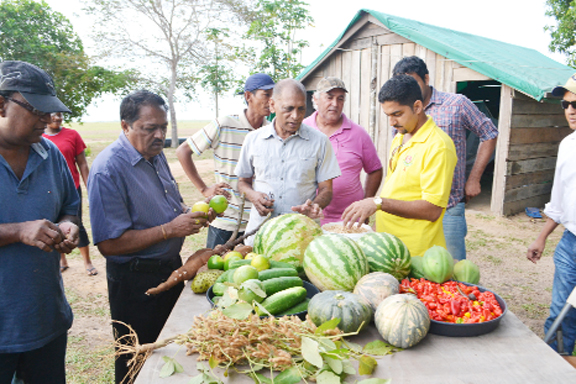A Barbados company is pushing ahead with a mega farm in Region Nine, which will have rice as its centrepiece with 120 acres of the crop currently under cultivation and another 980 acres expected to be sown by the end of June.
The project-operated by the Simpson family of Barbados-has been in the making since 2010. In September 2010, then Agriculture Minister Robert Persaud had said that the project at Santa Fe in the North Rupununi had seen some $156 million being spent up to that point. This year, the company stepped up the pace with the sowing of rice as it expanded its operation.
The Government Information Agency (GINA) reported on Friday that along with the cultivated areas, the company has almost completed a state-of-the-art rice mill with huge silos which will be used to store the paddy harvested from the large fields. Later this year, with 1,000 acres of upland rice being cultivated with the zero tillage technology/method under the project, rice would no longer have to be transported to Lethem from Georgetown or Brazil, GINA said.
Minister of Agriculture Dr Leslie Ramsammy, Minister in the Ministry Alli Baksh and a team recently visited the project where they interacted with the Blue Wave investors and staff, GINA reported. It added that the project is being managed and supervised by Guyanese Richard Vasconcellos. The venture is being undertaken through a combination of local and international expertise. Of the 60 employees on the site, 57 are Guyanese from Region 9 and the others are Brazilian consultants, according to GINA.
Ramsammy thanked the Simpson family for responding to Guyana’s call for agricultural investment. Discussions and the strategy established for this project commenced in 2010 with former President Bharrat Jagdeo, GINA reported. “This is another example not only of the Jagdeo Initiative working, but the amount of food that will be produced at Santa Fe will be beyond anything that Region 9 can consume, and therefore Santa Fe is meeting another objective of the Jagdeo Initiative which is that Guyana becomes firmly established as the food basket of the Caribbean,” Ramsammy was quoted as saying. He added that within the one-year period a lot has been done and the investors must be commended for taking on such a herculean task.

“What I am seeing here in Santa Fe is an impressive operation and it is multi-purpose,” Baksh said. He noted that the project would be extended and will see not only the cultivation of rice, but soya beans, rearing of cattle, sheep, aquaculture and pigs in the future. “This is a vast investment, and, we from the Ministry of Agriculture are very satisfied so far. Looking at this project at its initial stage a lot of investment has already been done,” the minister said.
GINA reported that the Santa Fe project, which is taking an Integrated Mega Farm approach is expected to utilise savannah land for soya beans, as well as corn cultivation which will be mainly used for animal feed production locally and regionally. This will help the Caribbean reduce its total import of these essential foods from North America and other regions and allow for trading and expanded markets within the region. It is also cultivating cassava, watermelons, passion fruit and other cash crops as well as some other perennials.
GINA said that Santa Fe’s consultants have assured Ramsammy that they will share all their knowledge and skills with persons manning other projects such as the St Ignatius Shade House project and the Moco Moco rice/beans project, hence reducing cost, and providing the necessary skills to villagers.
Ramsammy had highlighted the need for Guyanese to be trained in new and innovative technology and said in this regard the Santa Fe venture stands as a good example of where Guyana wants to be in terms of expanding agriculture. He reiterated that President Donald Ramotar and Jagdeo have both endorsed the notion that Guyana must not be shy to import technology and the people who can introduce the technology.
“Brazil is one of the global economic giants, it has developed its own technology, its own plant varieties and Guyana has looked to Europe and North America often. We should not stop looking there, but at the same time we shouldn’t be looking one way … we should be looking next door to our neighbour, which has been successful and has become one of the top 20 economies in the world,” the minister was quoted as saying.








